WHY THE NHRA NEEDED TO CHANGE THE CHRISTMAS TREE ROUTINE
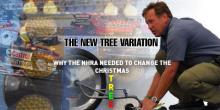
Or maybe the difference between red-lighting, or being late to leave was the ability to count “one-one-thousand, go”, once all four stage lights were lit.
Allegations of nitro drivers successfully guessing the tree was enough incentive for the newly formed nitro drivers committee to approach PRO and the NHRA management about putting the driver’s role back into the start by implementing a variation of time between the stage lights and the amber lights.
The move has more drivers seeing red during the first three NHRA events this season than in 2008, however, no one appears to be unhappy with the change.
Allegations of Drivers Guessing the Tree Prompted a Change …
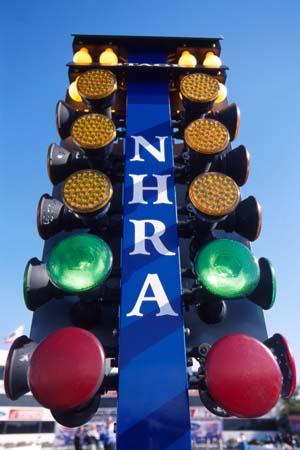 Maybe, they were just naturally talented. Maybe, there just naturally reacted faster.
Maybe, they were just naturally talented. Maybe, there just naturally reacted faster.
Or maybe the difference between red-lighting, or being late to leave was the ability to count “one-one-thousand, go”, once all four stage lights were lit.
Allegations of nitro drivers successfully guessing the tree was enough incentive for the newly formed nitro drivers committee to approach PRO and the NHRA management about putting the driver’s role back into the start by implementing a variation of time between the stage lights and the amber lights.
The move has more drivers seeing red during the first three NHRA events this season than in 2008, however, no one appears to be unhappy with the change.
“The NHRA didn’t set out to change the tree; the idea was brought to their attention by the fuel drivers,” Jeff Foster of Compulink said.
Foster handles the installation of NHRA timing systems as a member of the Compulink team. The Compulink team was responsible for developing the features on today’s drag racing Christmas tree as the auto-start feature, which regulates the amount of time one driver must stage after their opponent has staged, to the current feature preventing drivers from guessing the activation of the tree.
a d v e r t i s e m e n t
Click to visit our sponsor's website
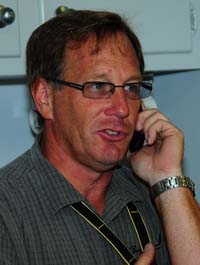
“There are actually three separate programs now,” Foster explained. “There’s one program for everybody, the additional one for Top Fuel and Funny Car and now one for Pro Stock.”
Essentially this new feature allows the computer to work the tree in much the same fashion as the tough-as-nails but fair legendary chief starter Buster Couch did in the early years of NHRA drag racing.
If you’ve ever heard tales of Buster dealing with game-playing drivers, and they seem unbelievable, don’t discount them.
Current Funny Car point leader Ron Capps watched the NHRA go through changes with the tree to the point the iconic device became nothing more than a robot. The implementation of the variable, he admits, is a bit like having the now deceased Buster back on the starting line.
“You didn’t leave until you saw amber,” Capps said. “If he wanted to make you wait, you waited. That’s when you hear Don Prudhomme and Don Schumacher talk about the old days. That needs to be back the way it was.”
Capps believes the move by the NHRA was a step in the right direction.
“It’s made our class a little bit more interesting because now people have to be disciplined enough to leave when they see yellow,” Capps said. “I think it’s been making a little bit for up-and-down racing and better racing.”
a d v e r t i s e m e n t
Click to visit our sponsor's website
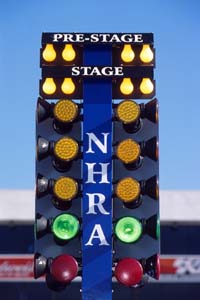 If you watched the NHRA Lucas Slick Mist Nationals, chances are you noticed three of the first four pairs of Top Fuel eliminations were decided on a red-light start.
If you watched the NHRA Lucas Slick Mist Nationals, chances are you noticed three of the first four pairs of Top Fuel eliminations were decided on a red-light start.Conspiracy theorists will likely say that the third match, Tony Schumacher versus Troy Buff, just didn’t jibe up based on what they saw during ESPN2 coverage.
With both of Buff’s stage lights still shining, the red-light was illuminated.
The standard rule of thumb is when a driver fouls it means they have turned out the stage light before the green light illuminates. In the instance of Buff’s foul, the power to the stage lights had been turned off but because they are of the incandescent design, the process for the light to go out generally takes about .03 of a second. Add into the equation the fact the amber, green and red-lights are LED bulbs and that’s how the Buff situation transpired.
The logical next question is why didn’t the stage lights convert to LED from incandescent at the same time the rest of the tree did?
The fact is, its not easy as unscrewing one bulb and replacing it with a different style. Making the change is still in the development stages.
“We have 14 different modules on the work bench now,” explained Jeff Foster of Compulink, the NHRA’s official timing equipment provider. “One looks promising but we are still in the life cycle process of testing. We are still beating on them with hammers to see how they handle the vibration of [nitro] cars and stuff like that.”
Foster told CompetitionPlus.com that he hopes to have the LED pre-stage and stage lights implemented by Labor Day weekend for the NHRA U.S. Nationals in Indianapolis.
A pair of drivers could get a quick tree while the next pairing could end up on the slow end of the variation spectrum.
The auto-start system limits the time to seven seconds that a driver can stage once their opponent has lit both pre-stage and stage beams. The lower end of the spectrum could extend the long suffering driver’s wait to 8.3 seconds before the green light.
The tree is actually activated by current NHRA Chief Starter Rick Stewart once both drivers have lit the pre-stage beams.
With the old system, once all four bulbs were lit, the tree would activate usually within .8 of a second, depending on the facility. A driver could watch a few cars run and typically gain a feel of the tree’s timing and create a counting system that would allow them to “guess” the tree.
Capps is glad to welcome back the driver part of the equation even though he was one of those drivers at the first event of the season that was held up by the new system.
“It caught the drivers by surprise,” Capps said. “I almost red lit. We were more excited about how the tree made us wait. We were both in the cars ready to push the gas.”
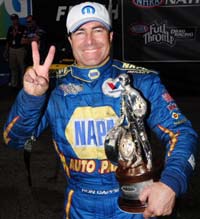
Capps believes that even though this new system can be perceived as taking a step backwards, in the long run it will create a better race in the long run.
“I think if there’s any drivers complaining, then they need to go back and practice some more,” Capps said. “I’m saying that because I could very well red light the next race. But the fact is we did it as a group because we wanted to bring the driver back into it more.”
ad v e r t i s e m e n t
Click to visit our sponsor's website
courtesy of COMPULINK
Q. - Who and when is the Autostart activate?
A. - The starter activates the system when both cars are in pre-stage and all is safe to go. He may activate as late as when both cars are in the stage lights.
Q. What is the time delay when the system counts down?
A - a. Both stage lights must be solid for this time (.5 for Pros.) This count is called Stage minimum and prevents the system from starting with a bump of the stage light during the staging process.
b. After the Stage minimum time then the countdown to the ambers start, this is called Stage to Start and is adjustable also the standard is .3 seconds for all Pros. Then the computer adds a variable in to each run of 0.0 to 0.5 seconds for TF and FC and 0.0 to 0.3 for PS.
c. So the total count down from stage on to ambers is Stage minimum plus stage to start plus the variable.
So in TF and FC .5 seconds + .3 seconds 0.0 to 0.5 seconds = 0.8 to 1.30 seconds from both solid stage to ambers.
And PS .5 seconds + .3 seconds 0.0 to 0.3 seconds = 0.8 to 1.10 seconds from both solid stage to ambers.
Q. - If a competitor lights both pre-stage and stage before the other racer lights the pre-stage, has the system been activated?
A. No, the system must see 3 lights to activate the Time out count. This part is a 7 seconds count that at the end of if the second car is still not in the stage, the system will trigger the tree.
Antron Brown, current point leader in Top Fuel, knows a thing or two about starting line discipline coming from the Pro Stock Motorcycle ranks. The sophomore driver is consistently among the quicker reacting drivers in the class and now that he’s in a Top Fuel dragster he’s learning the tree can be more forgiving in a rail than on a motorcycle.
The experience of becoming disciplined on a bike translates to the perfect scenario for Brown with the implementation of the tree variation.
“It makes it more competitive for our classes,” Brown admitted. “Now you have to be a disciplined driver, which [for] me coming from bikes, we always left when I saw yellow, I was able to red light. But, [if] I leave when I see yellow in Top Fuel I don’t have to worry about red lighting.”
Foster told CompetitionPlus.com that the Pro Stock drivers asked the NHRA to implement the variable into their tree for 2009 as well. There have only been two red-lights in Pro Stock thus far. Pro Stock Motorcycles are exempt from the new system of varying the tree starts.
Capps believes the decision to stagger the tree start was voted unanimous for a reason.
“I think you’re going to see one more change to the tree, a small amount, nobody is going to notice,” Capps said. “It’s going to bring the drivers back into it. It needs to reward guys like Antron, the guys that are really quick, that can wait and anticipate and leave on yellow. That’s what needs to happen. There were too many guys taking shots and guesses. That’s not good when you come home to your kid and you explain a loss because a guy guessed at a tree.”
| {loadposition feedback} |





